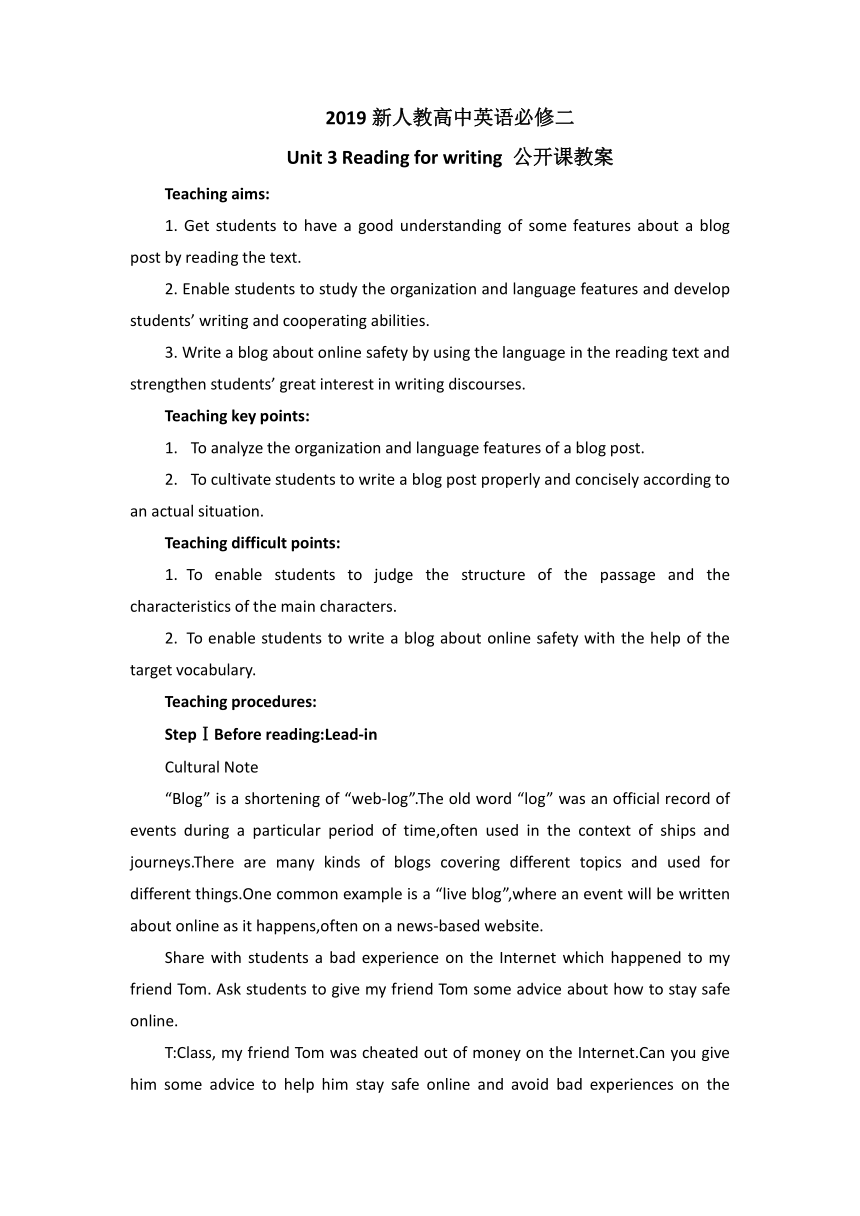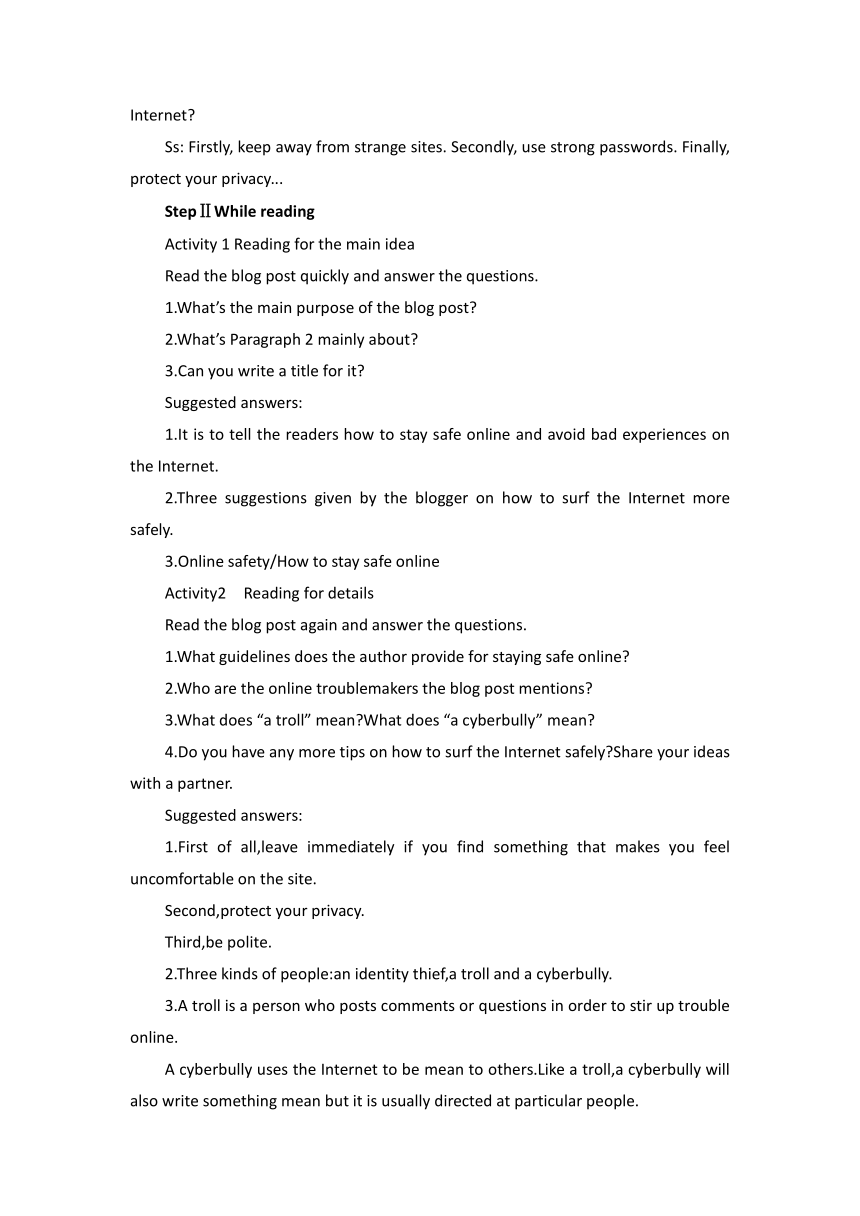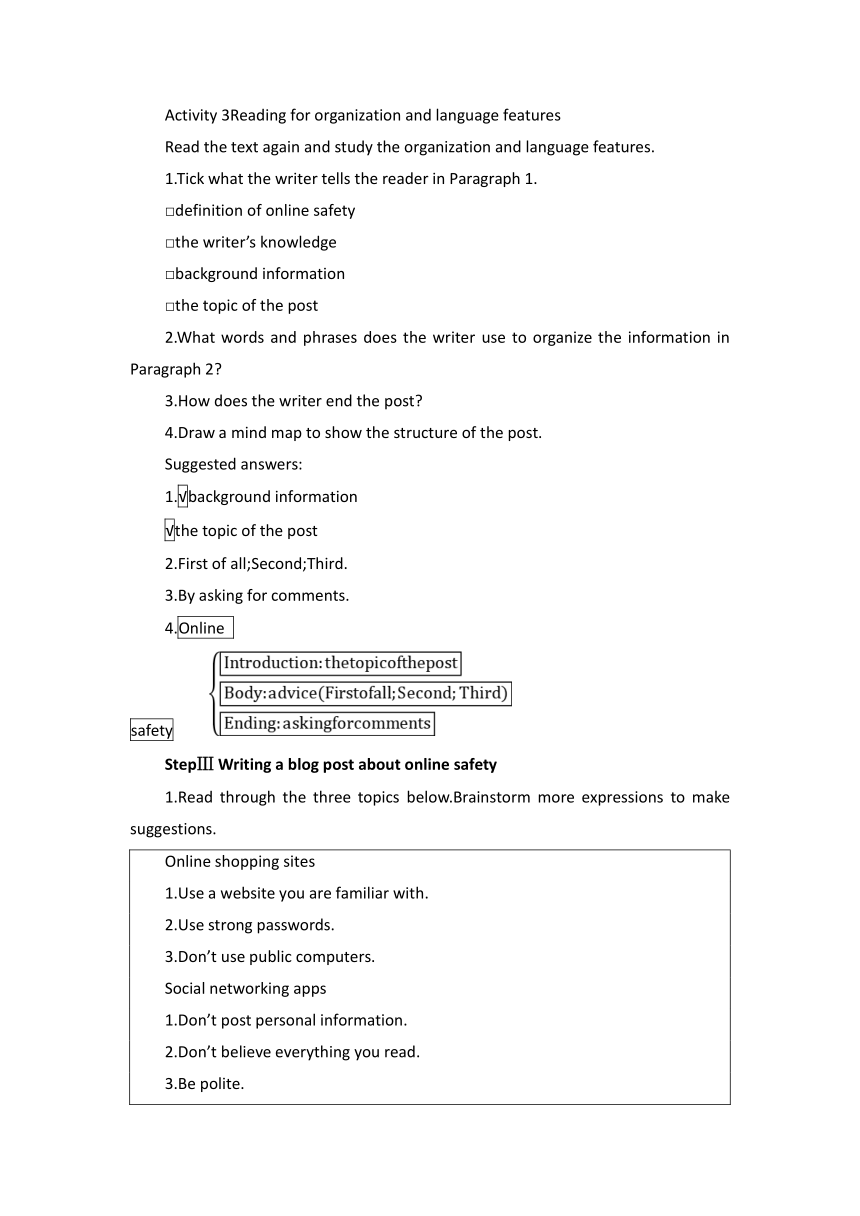人教版(2019) 必修第二册 Unit 3 The Internet Reading for writing公开课教案-
文档属性
| 名称 | 人教版(2019) 必修第二册 Unit 3 The Internet Reading for writing公开课教案- |  | |
| 格式 | doc | ||
| 文件大小 | 60.0KB | ||
| 资源类型 | 教案 | ||
| 版本资源 | 人教版(2019) | ||
| 科目 | 英语 | ||
| 更新时间 | 2022-10-31 09:09:34 | ||
图片预览



文档简介
2019新人教高中英语必修二
Unit 3 Reading for writing 公开课教案
Teaching aims:
1. Get students to have a good understanding of some features about a blog post by reading the text.
2. Enable students to study the organization and language features and develop students’ writing and cooperating abilities.
3. Write a blog about online safety by using the language in the reading text and strengthen students’ great interest in writing discourses.
Teaching key points:
To analyze the organization and language features of a blog post.
To cultivate students to write a blog post properly and concisely according to an actual situation.
Teaching difficult points:
To enable students to judge the structure of the passage and the characteristics of the main characters.
To enable students to write a blog about online safety with the help of the target vocabulary.
Teaching procedures:
StepⅠBefore reading:Lead-in
Cultural Note
“Blog” is a shortening of “web-log”.The old word “log” was an official record of events during a particular period of time,often used in the context of ships and journeys.There are many kinds of blogs covering different topics and used for different things.One common example is a “live blog”,where an event will be written about online as it happens,often on a news-based website.
Share with students a bad experience on the Internet which happened to my friend Tom. Ask students to give my friend Tom some advice about how to stay safe online.
T:Class, my friend Tom was cheated out of money on the Internet.Can you give him some advice to help him stay safe online and avoid bad experiences on the Internet
Ss: Firstly, keep away from strange sites. Secondly, use strong passwords. Finally, protect your privacy...
StepⅡWhile reading
Activity 1 Reading for the main idea
Read the blog post quickly and answer the questions.
1.What’s the main purpose of the blog post
2.What’s Paragraph 2 mainly about
3.Can you write a title for it
Suggested answers:
1.It is to tell the readers how to stay safe online and avoid bad experiences on the Internet.
2.Three suggestions given by the blogger on how to surf the Internet more safely.
3.Online safety/How to stay safe online
Activity2 Reading for details
Read the blog post again and answer the questions.
1.What guidelines does the author provide for staying safe online
2.Who are the online troublemakers the blog post mentions
3.What does “a troll” mean What does “a cyberbully” mean
4.Do you have any more tips on how to surf the Internet safely Share your ideas with a partner.
Suggested answers:
1.First of all,leave immediately if you find something that makes you feel uncomfortable on the site.
Second,protect your privacy.
Third,be polite.
2.Three kinds of people:an identity thief,a troll and a cyberbully.
3.A troll is a person who posts comments or questions in order to stir up trouble online.
A cyberbully uses the Internet to be mean to others.Like a troll,a cyberbully will also write something mean but it is usually directed at particular people.
Activity 3Reading for organization and language features
Read the text again and study the organization and language features.
1.Tick what the writer tells the reader in Paragraph 1.
□definition of online safety
□the writer’s knowledge
□background information
□the topic of the post
2.What words and phrases does the writer use to organize the information in Paragraph 2
3.How does the writer end the post
4.Draw a mind map to show the structure of the post.
Suggested answers:
1.√background information
√the topic of the post
2.First of all;Second;Third.
3.By asking for comments.
4.Online
safety
StepⅢ Writing a blog post about online safety
1.Read through the three topics below.Brainstorm more expressions to make suggestions.
Online shopping sites
1.Use a website you are familiar with.
2.Use strong passwords.
3.Don’t use public computers.
Social networking apps
1.Don’t post personal information.
2.Don’t believe everything you read.
3.Be polite.
Online chat rooms
1.Don’t give out too much information.
2.Never meet someone you met online alone.
2.Choose one topic to write about.Organize your draft according to the outline below.
Introduction:Tell the reader about yourself and what you know about topic.
Body:Tell the reader what they should do or keep in mind.Define new words or key terms.
Ending:End by asking the readers to write comments.
Suggested answers:
1.I recommend that you should...
I think you should...
Why not...
It is a good idea/choice to do...
How about/What about doing...
I suggest that you should...
You’d better...
2.Version 1
I’m a senior high school student.Today I want to blog about a question—how to protect ourselves from being cheated when shopping online.
First of all,you’d better use a website you are familiar with.Try not to use strange websites.Second,use strong passwords.If your password is too short and simple,change it immediately.A good one should have a mixture of letters,numbers and other characters.It should be completely random.Third,I suggest that you should not use public computers when shopping.It makes your private information in risk of being stolen.
If you have some good advice for staying safe when shopping online,please post your comments.
Version 2
Hello,everyone.I’m a senior high school student.Today I want to blog about something that I think is very important.Unfortunately,I know about the topic well because I made a silly mistake.That was to make my email password “password 123”!
About six months ago,someone hacked my email account.That means they found out my password,then tried to use my account to take money from me and sent viruses to all my contacts! Luckily my friend told me when she got a strange email from me,so I changed my password immediately.I read about how to make a good password.A good one should have a mixture of both upper case (large capital) letters and lower case (small) letters,numbers and other characters.It also should not be a name or date or anything someone can guess.It should be completely random,that is,it shouldn’t make sense! Although it can be hard to remember lots of complicated passwords,it is worth it! These days you can also use a password manager.This is a special program that helps you manage passwords for all your different accounts.
Although I hope nothing similar has happened to my readers,please comment if you have had a similar experience or if you have any more good ideas about making your passwords super safe! Catch you later!
StepⅣ Evaluating and polishing the draft
1.Exchange drafts.Use the checklist to give feedback on each other’s draft.
About the passage Self check
Organization Is the structure clear (3 parts)
Content(内容) Is it written in a logical way
Are the contents clear and necessary
Language Do you use the sentences you have learned
Do you use correct spelling,punctuation,and capitalization
Are there any grammar mistakes
Handwriting Is the handwriting neat and clear
2.Polish your draft and share with your partners.
StepⅤ Homework
Continue to polish your draft.
Read through the passage on page76 of Workbook and finish the writing.
Unit 3 Reading for writing 公开课教案
Teaching aims:
1. Get students to have a good understanding of some features about a blog post by reading the text.
2. Enable students to study the organization and language features and develop students’ writing and cooperating abilities.
3. Write a blog about online safety by using the language in the reading text and strengthen students’ great interest in writing discourses.
Teaching key points:
To analyze the organization and language features of a blog post.
To cultivate students to write a blog post properly and concisely according to an actual situation.
Teaching difficult points:
To enable students to judge the structure of the passage and the characteristics of the main characters.
To enable students to write a blog about online safety with the help of the target vocabulary.
Teaching procedures:
StepⅠBefore reading:Lead-in
Cultural Note
“Blog” is a shortening of “web-log”.The old word “log” was an official record of events during a particular period of time,often used in the context of ships and journeys.There are many kinds of blogs covering different topics and used for different things.One common example is a “live blog”,where an event will be written about online as it happens,often on a news-based website.
Share with students a bad experience on the Internet which happened to my friend Tom. Ask students to give my friend Tom some advice about how to stay safe online.
T:Class, my friend Tom was cheated out of money on the Internet.Can you give him some advice to help him stay safe online and avoid bad experiences on the Internet
Ss: Firstly, keep away from strange sites. Secondly, use strong passwords. Finally, protect your privacy...
StepⅡWhile reading
Activity 1 Reading for the main idea
Read the blog post quickly and answer the questions.
1.What’s the main purpose of the blog post
2.What’s Paragraph 2 mainly about
3.Can you write a title for it
Suggested answers:
1.It is to tell the readers how to stay safe online and avoid bad experiences on the Internet.
2.Three suggestions given by the blogger on how to surf the Internet more safely.
3.Online safety/How to stay safe online
Activity2 Reading for details
Read the blog post again and answer the questions.
1.What guidelines does the author provide for staying safe online
2.Who are the online troublemakers the blog post mentions
3.What does “a troll” mean What does “a cyberbully” mean
4.Do you have any more tips on how to surf the Internet safely Share your ideas with a partner.
Suggested answers:
1.First of all,leave immediately if you find something that makes you feel uncomfortable on the site.
Second,protect your privacy.
Third,be polite.
2.Three kinds of people:an identity thief,a troll and a cyberbully.
3.A troll is a person who posts comments or questions in order to stir up trouble online.
A cyberbully uses the Internet to be mean to others.Like a troll,a cyberbully will also write something mean but it is usually directed at particular people.
Activity 3Reading for organization and language features
Read the text again and study the organization and language features.
1.Tick what the writer tells the reader in Paragraph 1.
□definition of online safety
□the writer’s knowledge
□background information
□the topic of the post
2.What words and phrases does the writer use to organize the information in Paragraph 2
3.How does the writer end the post
4.Draw a mind map to show the structure of the post.
Suggested answers:
1.√background information
√the topic of the post
2.First of all;Second;Third.
3.By asking for comments.
4.Online
safety
StepⅢ Writing a blog post about online safety
1.Read through the three topics below.Brainstorm more expressions to make suggestions.
Online shopping sites
1.Use a website you are familiar with.
2.Use strong passwords.
3.Don’t use public computers.
Social networking apps
1.Don’t post personal information.
2.Don’t believe everything you read.
3.Be polite.
Online chat rooms
1.Don’t give out too much information.
2.Never meet someone you met online alone.
2.Choose one topic to write about.Organize your draft according to the outline below.
Introduction:Tell the reader about yourself and what you know about topic.
Body:Tell the reader what they should do or keep in mind.Define new words or key terms.
Ending:End by asking the readers to write comments.
Suggested answers:
1.I recommend that you should...
I think you should...
Why not...
It is a good idea/choice to do...
How about/What about doing...
I suggest that you should...
You’d better...
2.Version 1
I’m a senior high school student.Today I want to blog about a question—how to protect ourselves from being cheated when shopping online.
First of all,you’d better use a website you are familiar with.Try not to use strange websites.Second,use strong passwords.If your password is too short and simple,change it immediately.A good one should have a mixture of letters,numbers and other characters.It should be completely random.Third,I suggest that you should not use public computers when shopping.It makes your private information in risk of being stolen.
If you have some good advice for staying safe when shopping online,please post your comments.
Version 2
Hello,everyone.I’m a senior high school student.Today I want to blog about something that I think is very important.Unfortunately,I know about the topic well because I made a silly mistake.That was to make my email password “password 123”!
About six months ago,someone hacked my email account.That means they found out my password,then tried to use my account to take money from me and sent viruses to all my contacts! Luckily my friend told me when she got a strange email from me,so I changed my password immediately.I read about how to make a good password.A good one should have a mixture of both upper case (large capital) letters and lower case (small) letters,numbers and other characters.It also should not be a name or date or anything someone can guess.It should be completely random,that is,it shouldn’t make sense! Although it can be hard to remember lots of complicated passwords,it is worth it! These days you can also use a password manager.This is a special program that helps you manage passwords for all your different accounts.
Although I hope nothing similar has happened to my readers,please comment if you have had a similar experience or if you have any more good ideas about making your passwords super safe! Catch you later!
StepⅣ Evaluating and polishing the draft
1.Exchange drafts.Use the checklist to give feedback on each other’s draft.
About the passage Self check
Organization Is the structure clear (3 parts)
Content(内容) Is it written in a logical way
Are the contents clear and necessary
Language Do you use the sentences you have learned
Do you use correct spelling,punctuation,and capitalization
Are there any grammar mistakes
Handwriting Is the handwriting neat and clear
2.Polish your draft and share with your partners.
StepⅤ Homework
Continue to polish your draft.
Read through the passage on page76 of Workbook and finish the writing.
